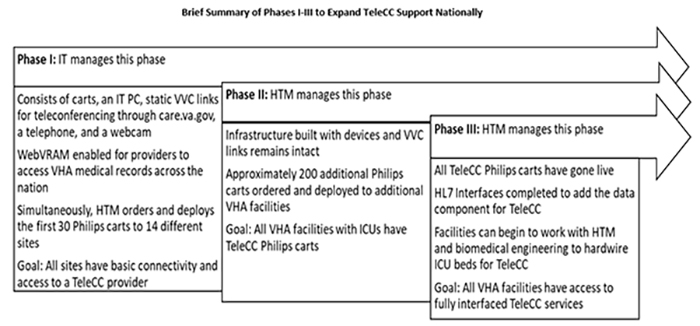
May 2020
Rapid Expansion of TeleCritical Care to Support Intensive Care Needs Across the NationWithin a few weeks, the C5 Team was able to facilitate 24/7 critical care assistance to any VA facility across the nation that had responded to the memos. Takeaway: In a few short weeks, several individuals from offices across the VA healthcare system came together as a team to respond to the COVID-19 pandemic and create an infrastructure for the delivery of TeleCritical Care (TeleCC) services across the nation. The Virtual Specialty Care QUERI partners with Tele-Critical Care and Offices of Rural Health and Connected Care. Jaime Wilson describes their ongoing collaborations and VA’s rapid deployment of Tele-Critical Care. On March 10, 2020, I was running a regular, virtual monthly TeleCC Advisory Committee meeting when the discussion turned to the national COVID-19 response. We discussed the looming pandemic and how to support the existing VA intensive care infrastructure, especially facilities experiencing a surge. Kevin Galpin, MD, Executive Director of VHA Telehealth Services in the Office of Connected Care, took the lead in securing the funding needed to rapidly expand intensivist support to VA healthcare facilities across the nation. We quickly created a COVID Response Workgroup, consisting of about 35 individuals in all US time zones, and held our first meeting on March 12. From this point, the entire workgroup met several times per week to plan and execute Phase I of a 3-phase process to ensure national access to 24/7 intensivist services in the face of a national emergency. 
VISNs set up audio/visual technology to access TeleCC services The first memo went out to the VISN (Veterans Integrated Service Networks) Directors on March 18, requesting that facilities designate any devices on carts that they could potentially set up with audio/visual technology for access to TeleCC services. Initially, the memo required 67 of 110 VA healthcare facilities with ICUs (intensive care units) – without current access to TeleCC – to participate, but after receiving feedback from sites, the program was opened to all 110 VA facilities with ICUs. Additional requests from smaller VHA facilities (without ICUs) seeking critical care assistance prompted the team to extend the memo to include any VHA facility needing support. During Phase I, the TeleCC response to COVID-19 was intended to offer a “light” version of TeleCC services to expedite the capability of offering 24/7 support to any facility in need. This “light” version consisted of receiving a facility spreadsheet with points of contact (POCs) for a newly established National ICU Phone Book and setting up designated devices with static VVC links providing access to a Virtual Medical Room (VMR). Within the VMR, audio/visual communication between bedside and TeleCC providers could occur. The Iron Bow team put in several hours with individuals at each facility in order to confirm, set up, and test each of these devices allowing access to the VMR. C5: the nationwide COVID TeleHealth Critical Care Cooperative Community Momentum built through the next week, and the workgroup came up with the name—the “COVID TeleHealth Critical Care Cooperative Community” (C5). The C5 workgroup expands the already strong connections between the Virtual Specialty Care QUERI and its operations partners from Connected Care and Rural Health. To expand the TeleCC workforce and to support the number of potential consults, a second Memo went out to VISN Directors requesting at least one intensivist from each VISN willing to participate as a C5 provider. The “community” of C5 providers was sent through a training and onboarding process using the existing Telehealth Emergency Management team, the Disaster Emergency Medical Personnel System (DEMPS), the Light Electronic Action Framework team, and the two TeleCC core hub teams. C5 providers were given national credentialing and privileging by proxy, as well as Web VistA Remote Access Management (WebVRAM), which enabled national read/write access for any Veteran chart across the U.S. during a C5 consultation. After completing this process, C5 and TeleCC providers became capable and available 24/7 to provide critical care consults, put in orders, and assist with ventilator setting changes. C5 Team facilitates 24/7 critical care assistance to VA facilities across the nation In addition to training for C5 and TeleCC providers, bedside clinicians and IT personnel were encouraged to attend one of the daily townhall-style trainings that were provided by the TeleCC core hub teams. Hundreds of VA employees from participating facilities attended the trainings. Within a few weeks, the C5 Team was able to facilitate 24/7 critical care assistance to any VA facility across the nation that had responded to the memos. Simultaneously, the Healthcare Technology Management office was working to develop and deploy approximately 225 TeleCC interfaced Philips carts (patient monitoring device) to VA facilities across the nation. The first 14 of these Philips carts have been received by sites, which indicates the transition into Phase II. Although Phase I of C5 isn’t the fully interfaced TeleCC program, it is rapidly deployable nationally, and is meant to assist facilities with a surge of ICU patients due to COVID-19 or staffing disruptions due to quarantine or illness. C5 capability spreads Currently, 90 facilities have requested C5 capability. Five of these sites do not currently have an ICU, meaning that C5 has filled a gap in intensivist services to sites who may not normally have access or a need outside of COVID-19. In addition, leadership at several facilities created additional units outside of their regular ICUs in areas such as endoscopy suites, which had temporarily halted services. Despite the many challenges to getting this national VA program up and running within a few weeks, the amazing teamwork of VA staff, providers, clinicians, consultants, leaders, and operations partners from Connected Care and Rural Health made this effort possible. Jaime Wilson, DNP, RN, PCCN-K Nurse Director, VHA Office of Rural Health Rural Scholars Fellowship Program Facilitator, National TeleCritical Care Advisory Committee |